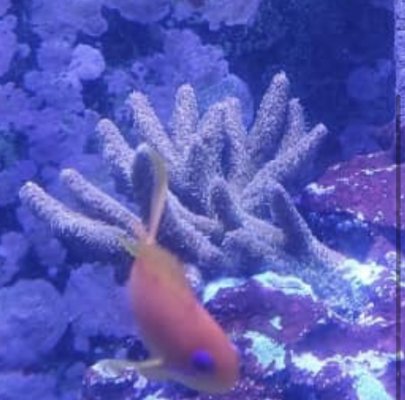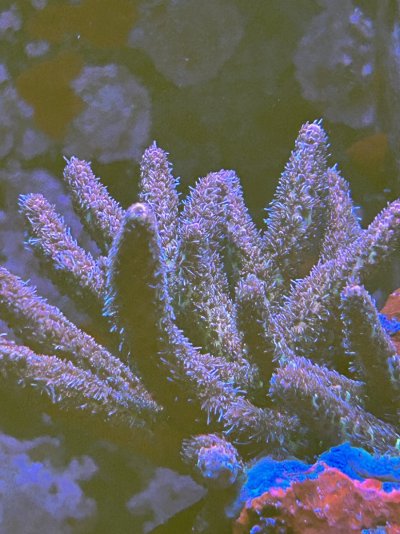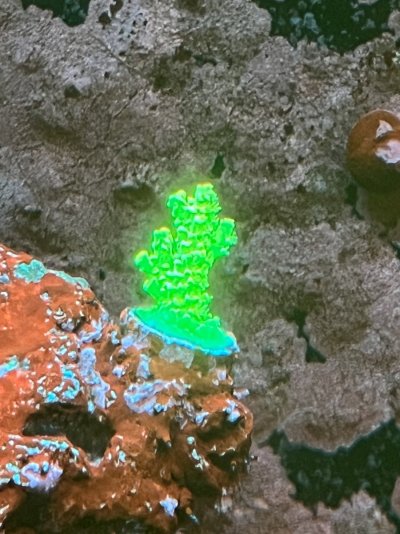- Joined
- Jan 12, 2019
- Messages
- 765
- Reaction score
- 386
When I say high par, I mean 600-800 at the top of the tank and 300 on the sandbed
Lately, I’ve been noticing my acros are alive, growing, and I don’t have any pests. They’re super colorful, but the growth is slow, and the PE is meh but it’s consistently there. One exception, is my red planet colony that has MASSIVE pe. It’s getting hit directly by the edge of a 400w metal halide and heavy indirect mp60 flow at 80%. 750-800 par
However, all my other acros although alive and encrusting super slow.. seem to have a bright color but not quite a defined color. Take the Walt Disney for example - my frag is getting 800 par, just like the red planet at the top. But, it’s a super like/green yellow but no blue tips. Not fuzzy, PE is there all day just small.
My parameters:
Nitrates 28
Po4: .16
Sg 1.024 (raising it slowly to 1.026)
Alk 8.0-8.3 (maintained with kalk)
Calcium - 440
pH 8.1 -8.4
Mag 1420-1450
ICP tests done every 6 weeks in both RODI and tank. Trace elements manually dosed to bring up based on ICP testing.
I should say, my green slimer finally looks like it’s growing after 5.5 months in the tank. It gets about 400 par.
Maybe I’m just impatient, but I would still like to hear thoughts on this. Is there a guide or best practice for this? For example - 800 par you need 40 nitrates and .2 po4..
I added some pics, obviously the Disney pic is with an orange lens but that’s kind of how it reflects to the camera but to the eye it’s not as bright lime like that. Maybe 20% less bright than that but I can never grab a good pic of it. It’s encrusting, but I feel like my colors are off.
I should add - I dose nopox everyday to try and keep nitrates below 10 and po4 below .1 but obviously that’s out of whack right now and should come back to those levels in 2 weeks. But now that I’m here.. should I just let those nutrients go wild and see what happens?



Lately, I’ve been noticing my acros are alive, growing, and I don’t have any pests. They’re super colorful, but the growth is slow, and the PE is meh but it’s consistently there. One exception, is my red planet colony that has MASSIVE pe. It’s getting hit directly by the edge of a 400w metal halide and heavy indirect mp60 flow at 80%. 750-800 par
However, all my other acros although alive and encrusting super slow.. seem to have a bright color but not quite a defined color. Take the Walt Disney for example - my frag is getting 800 par, just like the red planet at the top. But, it’s a super like/green yellow but no blue tips. Not fuzzy, PE is there all day just small.
My parameters:
Nitrates 28
Po4: .16
Sg 1.024 (raising it slowly to 1.026)
Alk 8.0-8.3 (maintained with kalk)
Calcium - 440
pH 8.1 -8.4
Mag 1420-1450
ICP tests done every 6 weeks in both RODI and tank. Trace elements manually dosed to bring up based on ICP testing.
I should say, my green slimer finally looks like it’s growing after 5.5 months in the tank. It gets about 400 par.
Maybe I’m just impatient, but I would still like to hear thoughts on this. Is there a guide or best practice for this? For example - 800 par you need 40 nitrates and .2 po4..
I added some pics, obviously the Disney pic is with an orange lens but that’s kind of how it reflects to the camera but to the eye it’s not as bright lime like that. Maybe 20% less bright than that but I can never grab a good pic of it. It’s encrusting, but I feel like my colors are off.
I should add - I dose nopox everyday to try and keep nitrates below 10 and po4 below .1 but obviously that’s out of whack right now and should come back to those levels in 2 weeks. But now that I’m here.. should I just let those nutrients go wild and see what happens?
























